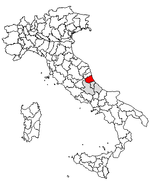
Tofo Sant'Eleuterio
Encyclopedia

Province of Teramo
The Province of Teramo is located in the Abruzzo region of Italy. Its capital is the city of Teramo. The province has an area of 1,948 km², a population of 296,063 , and is subdivided into 47 comunes , see Comunes of the Province of Teramo...
, in the Abruzzo
Abruzzo
Abruzzo is a region in Italy, its western border lying less than due east of Rome. Abruzzo borders the region of Marche to the north, Lazio to the west and south-west, Molise to the south-east, and the Adriatic Sea to the east...
region of central Italy. It is a frazione
Frazione
A frazione , in Italy, is the name given in administrative law to a type of territorial subdivision of a comune; for other administrative divisions, see municipio, circoscrizione, quartiere...
of the comune
Comune
In Italy, the comune is the basic administrative division, and may be properly approximated in casual speech by the English word township or municipality.-Importance and function:...
of Teramo
Teramo
Teramo is a city and comune in the central Italian region of Abruzzo, the capital of the province of Teramo.The city, from Rome, is situated between the highest mountains of the Apennines and the Adriatic coast...
. The inhabitants are known as Tofesi.
Geography
Tofo-Sant'Eleuterio lies about 10 km from Teramo, at an elevation of 250 m. It has two parts, Villa Tofo higher up, and Sant'Eleuterio below. The former is located on a hill from which one can see in the distance the Gran SassoGran Sasso
Gran Sasso d'Italia is a mountain located in the Abruzzo region of central Italy. The Gran Sasso forms the centerpiece of the Gran Sasso e Monti della Laga National Park which was established in 1993 and holds the highest mountains in continental Italy south of the Alps and is part of the...
, the highest peak in the Apennine Mountains
Apennine mountains
The Apennines or Apennine Mountains or Greek oros but just as often used alone as a noun. The ancient Greeks and Romans typically but not always used "mountain" in the singular to mean one or a range; thus, "the Apennine mountain" refers to the entire chain and is translated "the Apennine...
, as well as another peak, Montagna dei Fiori. According to tradition, Villa Tofo is named after the nearby tuff
Tuff
Tuff is a type of rock consisting of consolidated volcanic ash ejected from vents during a volcanic eruption. Tuff is sometimes called tufa, particularly when used as construction material, although tufa also refers to a quite different rock. Rock that contains greater than 50% tuff is considered...
rocks. The latter village takes its name from its patron, Saint Eleutherius
Pope Eleuterus
Pope Saint Eleuterus, or Eleutherius, was Bishop of Rome from about 174 to 189 . He was born in Nicopolis in Epirus. His name is Greek for free....
, the thirteenth pope. A church in the town is named in his honor.
About one mile from the village is the provincial road "Fonte a collina" (from the spring to the hill) which from Fiumicino (a village near San Nicolò a Tordino in the commune of Teramo leads to Sant'Onofrio in the commune of Campli. The town is adjacent to a ridge of the Fiumicino torrent, a tributary on the left bank of the Tordino river.
History
Historical records dating back to the 14th century document the presence of BenedictineBenedictine
Benedictine refers to the spirituality and consecrated life in accordance with the Rule of St Benedict, written by Benedict of Nursia in the sixth century for the cenobitic communities he founded in central Italy. The most notable of these is Monte Cassino, the first monastery founded by Benedict...
Monastery near Tofo on the banks of the Fiumicino. Few traces of this dwelling remain.
Beginning in the early 20th century, Tofo-Sant'Eleuterio entered a period of significant development. During the fascist period an elementary school, which had been housed in a private home, was constructed. A church dedicated to the Immaculate Conception
Immaculate Conception
The Immaculate Conception of Mary is a dogma of the Roman Catholic Church, according to which the Virgin Mary was conceived without any stain of original sin. It is one of the four dogmata in Roman Catholic Mariology...
was constructed during the mid 1960s. The church is by no means grandiose and was constructed in large part through the hard labor and economic support of the local citizens. Portions of the building materials were taken from the ruins of a nearby colonial bishopric tribunal dwelling. Mario Cerino, from Monticelli (another village in the commune of Teramo), donated the land where the church now stands. Surveys, designs andgeneral contracting services were carried out under the auspices of Giovanni Di Felice.
In the 1960s the village began to industrialize more heavily.

